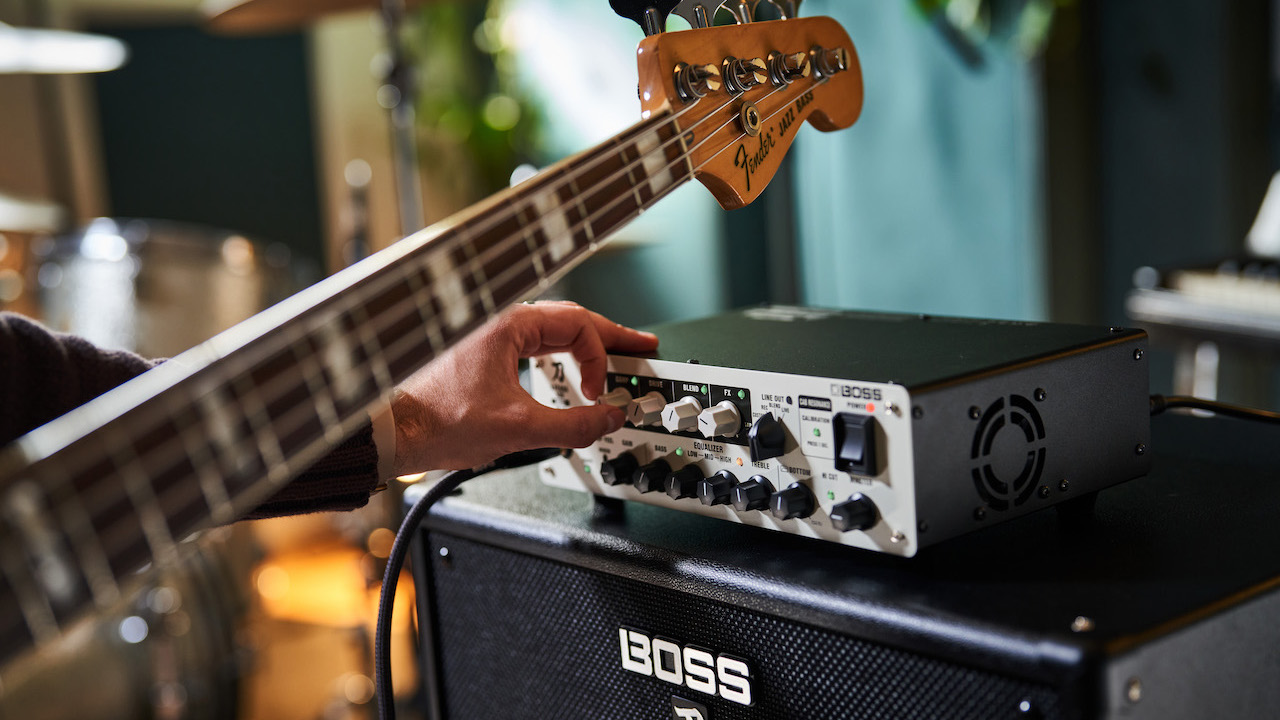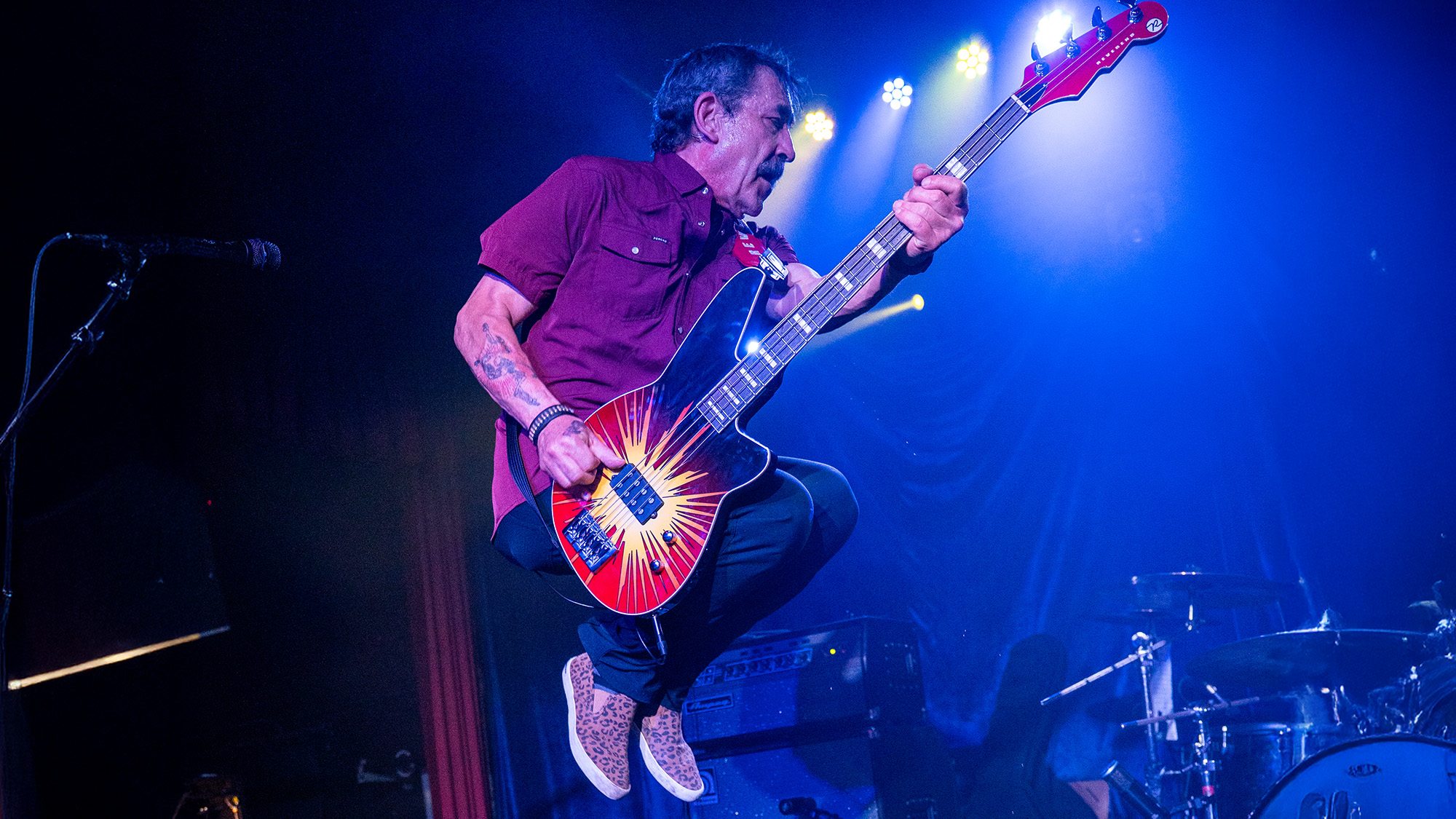Guitar World Verdict
The Katana-500 is a feature-packed bass amp that's ideal for the serious bassist looking for top-quality sounds in a gig-friendly package.
Pros
- +
Huge range of features.
- +
In-depth tweakability.
- +
We love the ease with which user presets can be made and altered.
Cons
- -
With so much on offer, making changes on the fly can be a little nerve-racking.
You can trust Guitar World
The Boss Katana bass amp range has been on our radar for some time now, having already experienced the Katana-110 Bass combo, followed by the bass-friendly wireless Katana Air. Now it’s time to welcome the first-ever Katana bass head.
This feature-packed bass amp boasts 500-watts of Class D power, onboard memory, a USB connector and optional Bluetooth adaptor, plus a range of built-in effects and sounds, with the extra ability to tailor those sounds via a downloadable app.
However, according to Boss, the real ace up the Katana-500 Bass Head’s sleeve is the company’s ‘Cabinet Resonance’ technology, which calibrates the amp’s circuitry to match the impedance and frequency response of your connected speaker cabinet.
On paper, the Katana-500 Bass Head offers a truckload of features for a pretty attractive price, but it’s hard to know what kind of sounds to expect from this highly original mix. Let’s find out how special it really is.
Features
The real plus points for this amp lie in the extensive tone controls, which should provide enough tone-shaping tools for even the most anal Rush tribute band.
Alongside bass, lo-mid, hi-mid and treble EQ controls, you can select preset curves via the Shape button – perfect if you’re in need of a giggable bass guitar sound in a hurry or if you’re a little unsure about tweaking the EQ.
The Gain control should be set as high as possible without the signal clipping, which will allow the signal to run through the preamp at its highest point before distorting. There’s also a neighbouring Pad button should you need to lower the sensitivity of the input stage.
All the latest guitar news, interviews, lessons, reviews, deals and more, direct to your inbox!
Next comes the FX section, which offers easy access to the amp's built-in effects. Three compression and limiter sounds are available via the Comp control, three drive effects of increasing intensity are available via the Drive control, and three modulation effects can be had via the FX control.




Each control has a corresponding button that allows you to toggle through the different effects you have stored on the amp. You can also change effect types with alternate selections via the Boss Tone Studio.
The businesslike feel of the controls, plus the colour changing indicators that change (from green to red to orange) as you toggle through each effect, create a really user-friendly feel.
There are emulations of three different mic settings on offer via the Line Out section, ranging from a distant mic’d sound or a close mic’d sound, or a blend of both. You can also create your own custom settings by downloading the Boss Tone Studio app.
Next up is a Bottom control that works as a low-frequency cut to eliminate any unwanted sub-bass rumble, and a Hi Cut button with three selectable frequencies. As if this weren’t enough, you can also select either Modern or Vintage – with distinct sounds in each – via an Amp Feel switch.

To engage the Cab Resonance feature, press and hold the Cab Resonance button until it blinks red, at which point the amp has measured the frequency response of your speaker cabinet. According to the manual, this feature uses “high-tech calibration to internally fine-tune the power output section for the user’s preferred speaker cabinet”. More on that later.
The Katana-500 Bass Head also allows for user-defined presets, which can be saved and recalled at the push of a button. Once you’ve set the front panel controls how you want them, press and hold the Memory button to store that setting. It really is that easy.
Check out the rear connection panel for even more options: there’s a balanced XLR output with direct, pre or post signals, left and right speaker-out sockets, a ground lift switch, a headphones/recording output, a USB connection, Bluetooth connection through an adaptor, and connections for footswitches and expression pedals.

Sounds
Now, the million dollar question: how does it sound? Thankfully, despite the sheer range of features, along with the scope with which you can shape your fundamental tone, you’d be hard-pushed to find a bass sound that you couldn’t gig with almost immediately.
There’s nothing fussy or complicated about the EQ. It works well and is perfect for bass. The more off-the-wall tone shaping options located either side may result in more tweaking than you might initially want to indulge in, but they're often too tempting to leave alone.
The sonic differences on offer from the Amp Feel switch can be quite subtle, yet each one has a very identifiable tonal character. The Modern setting offers a slightly scooped, punchy bass tone that’s great for funky fusion, though can sound a little too clinical for more traditional styles. In which case, switch to Vintage for a warmer, rounder Motown kind of bass sound.

The in-built effects work brilliantly, and the fact that you also get access to over 60 additional effects via the Boss Tone Studio software is a serious bonus.
The different effects are fun to trawl through in search of inspiration, and they make a good jumping-off point for fiddling around to create your own custom tones. There are some good distortions and compressors on offer, and the reverbs are excellent too.
Different cab and mic settings can also be selected, and there are different mic placement options, ranging from the middle to the edge of the speaker. Navigating the app takes a bit of practice, but it's great fun once you get the hang of it. We found the opportunities to experiment just too tempting to resist.

The last feature we want to touch on is the Cab Resonance technology. It’s fair to say that when it comes to speaker cabinets, it often comes down to personal preference, but either by accident or by design the slightly warm, vintage character of our in-house Ampeg cab became a great match for the clear and accurate nature of the Katana-500 Bass Head.
It's hard to know exactly what this electrical wizardry is doing most of the time – but it sounds good to us and we found it to be a welcome addition alongside the already pretty comprehensive feature set.
Verdict
The Katana 500 Bass Head lived in our home studio for a few days, and we enjoyed letting several bassists of different musical styles and abilities try it out. None of them were disappointed.
Creating new tones is a really enjoyable experience, and there’s always the feeling that the next sound you dial in will be better than the last. Coupled with the Boss Tone Studio effects, we found it really hard to stop checking out permutation after permutation.
There’s a lot to take in and we have to point out that there were times when we got a little lost when navigating all the options and, most importantly, finding that all-important killer tone on the fly. But for all its features, it remains functionally pretty straightforward, making for a great little amp that’s definitely punching above its weight.
At 500 watts, it may not be quite as powerful as its $799 price tag demands, but what it lacks in raw power, it makes up for in versatility. If you get a chance to audition one of these, hooked up to any speaker cabinet, you won’t be disappointed – though it doesn’t correct wrong notes!

Specs
PRICE: $799 / £734
MADE IN: Malaysia
TYPE: Class D bass amplifier
OUTPUT: (4 ohms) 500W (8 ohms) 250W
FEATURES: master volume, bass, lo mid, high mid & treble EQ controls, built-in compression, modulation and drive effects, 2 programmable amp models: modern & vintage, line out with emulated mic settings, cab resonance, programmable presets, XLR DI out, 2 x SpeakON outputs, ground-lift switch, USB port, Bluetooth adaptor connector, headphone & rec ouput
WEIGHT: 2.8 kg (6.3lbs)
DIMENSIONS: 29.8 (w) x 9.6 (h) x 21.2 (d) cm
CONTACT: Boss

Nick Wells was the Editor of Bass Guitar magazine from 2009 to 2011, before making strides into the world of Artist Relations with Sheldon Dingwall and Dingwall Guitars. He's also the producer of bass-centric documentaries, Walking the Changes and Beneath the Bassline, as well as Production Manager and Artist Liaison for ScottsBassLessons. In his free time, you'll find him jumping around his bedroom to Kool & The Gang while hammering the life out of his P-Bass.

